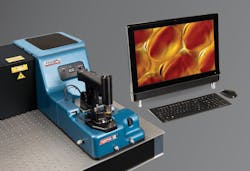Anasys nanoscale IR platform mixes atomic force microscopy and IR spectroscopy
The nanoIR platform measurement tool reveals the chemical composition of samples at the nanoscale. It combines the nanoscale spatial resolution capabilities of atomic force microscopy (AFM) with infrared spectroscopy’s ability to characterize and identify chemical species. Potential application areas include polymer blends, multilayer films, organic defect analysis, tissue morphology and histology, subcellular spectroscopy, and organic photovoltaics.
Anasys Instruments
Santa Barbara, CA
www.anasysinstruments.com
-----
PRESS RELEASE
Anasys Instruments Unveils Breakthrough Nanoscale Infrared Spectroscopy Technology
Date: February 24, 2010
For Immediate International Release
Santa Barbara, CA — Anasys Instruments is pleased to introduce its highly innovative nanoIR™ platform, a powerful new measurement tool that reveals the chemical composition of samples at the nanoscale.
“The goal of nanoIR technology is to overcome major barriers in AFM and conventional IR spectroscopy,” explains Dr. Craig Prater, Anasys Instruments’ chief technology officer. “AFM has outstanding resolution, but no ability to perform chemical spectroscopy. IR spectroscopy is a benchmark tool for chemical characterization, but lacks spatial resolution to address nanoscale problems. Anasys has focused on bridging these gaps.”
Anasys Instruments co-founder and vice president of product development Kevin Kjoller adds, “In addition to revealing chemical composition, the nanoIR system provides high-resolution characterization of local topographic, mechanical, and thermal properties. We are excited about providing a new tool to help facilitate materials and life science research at the nanoscale.”
The nanoIR system combines the nanoscale spatial resolution capabilities of atomic force microscopy (AFM) with infrared spectroscopy’s ability to characterize and identify chemical species. Users of nanoIR technology can quickly survey regions of a sample via AFM and then rapidly acquire high-resolution chemical spectra at the selected regions. The system can also be programmed to automatically acquire spectra from an array of points across the sample. Mechanical and thermal properties, such as local thermal transitions, may also be mapped with nanoscale resolution.
“Infrared microspectroscopy has already proven itself extremely valuable for addressing a wide range of problems in science and industry,” says Dr. Curtis Marcott, senior partner at Light Light Solutions and scientific advisor to Anasys Instruments. “I’m excited about the new technology from Anasys, as it will let us break through the submicron spatial resolution barrier and apply IR spectroscopy to new classes of problems beyond our current capabilities.” Dr. Marcott is the president-elect of the Society of Applied Spectroscopy and a retired research fellow from Procter & Gamble.
Potential nanoIR application areas include polymer blends, multilayer films and laminates, organic defect analysis, tissue morphology and histology, subcellular spectroscopy, and organic photovoltaics. Polymer spectra acquired with the nanoIR system are rich, interpretable, and have demonstrated good correlation with bulk Fourier transform infrared (FT-IR) spectra. The nanoIR software allows researchers to export nanoscale IR absorption spectra to standard analysis packages. With this interface, nanoIR spectra can be used to rapidly analyze samples and identify specific chemical components.
The nanoIR system is the result of several million dollars of government and private investment. Anasys Instruments was awarded $2.6 million in research grants from the NIST Advanced Technology Program and the National Science Foundation. U.S. and foreign patents are pending.
Subscribe now to Laser Focus World magazine; it's free!
